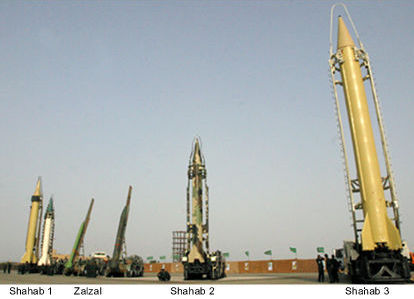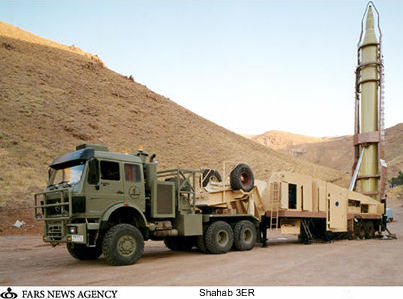Re: Consequences Of Attacking Iran And Why Tehran Is Not Worried

TEHRAN, Iran - The test-firing of three new models of sea missiles in the Persian Gulf should send a strong message to the United States to cease military manoeuvres in the zone, an Iranian navy chief said Friday. “Our enemies should keep their hostility off the Persian Gulf,” said Admiral Sardar Fadavi, deputy navy chief of the elite Revolutionary Guard, hours after the new missiles were tested. “They should not initiate any move that would make the region tense,” he said.
The Iranian military chief was answering a question on Iran’s state-run radio about whether the new manoeuvres were a response to a US-led military exercise in the zone earlier this week. The two-day U.S.-led naval exercise that finished Monday focused on surveillance, with warships from six countries tracking a vessel suspected of carrying nuclear components or illegal weapons. The countries that took part were Australia, Bahrain, Britain, France, Italy and the United States. The U.S. military would not comment Friday on the Iranian military statement, but said they had monitored the missile test-firing. “Countries throughout the region perform exercises on a regular basis, including Iran,” said Capt. Gary Arasin by telephone from the U.S. Central Command in Florida. “It’s something that we monitor.”
Iranian state television on Friday showed footage of Revolutionary Guards firing the missiles from mobile launching pads on the shore, and from warships. Iranian forces have previously test-fired missiles in the crowed Gulf waters, but the new manoeuvres, which began on Thursday, appeared to be geared at showing Iran’s discontent that U.S. and western warships had held an exercise so close to its territorial waters. “The manoeuvres are not a threat to any neighbouring country,” said Gen. Ali Fazli, the spokesman for the Iranian war-games, dubbed “Great Prophet.”
Iran nonetheless insisted the new sea missiles enhanced its military muscle in the Gulf, where a large proportion of the world’s oil is extracted. The weapons are “suitable for covering all the Strait of Hormuz, the Persian gulf and the sea of Oman” said Fadavi, the deputy navy chief. Some 20 per cent of the world’s oil supply passes every day through the strategic Strait of Hormuz. The three new types of missiles, named Noor, Kowsar, and Nasr, have a range of about 170 kilometres and were built for naval warfare, Iranian TV reported.
Earlier Iranian sea missiles had a range of 120 kilometres, Fadavi was quoted as saying. “The test-fired missiles are among the weapons whose capacities were improved by our domestic technology,” said Fadavi, implying that the weapons had first been acquired abroad. He said Iranian forces also intended to test air-to-ground missiles later Friday. The missiles will be fired from the first locally designed fighter plane, the bomber Saegheh, which is similar to the American F-18 fighter plane, he said.
While U.S. officials have suggested that Iran is exaggerating the capabilities of its newly developed weapons, Washington and its allies have been watching the country’s progress in missile technology with concern. The Iranian manoeuvres come as the UN Security Council is considering imposing sanctions on the Islamic Republic, which has ignored demands that it cease uranium enrichment, a process that can produce the fuel for nuclear reactors or material for atomic bombs. Russia, a veto yielding power at the Security Council, said it opposed the UN sanctions in their current form.

Iran test-fires new sea missiles Tells U.S. to cease manoeuvres in Gulf
TEHRAN, Iran - The test-firing of three new models of sea missiles in the Persian Gulf should send a strong message to the United States to cease military manoeuvres in the zone, an Iranian navy chief said Friday. “Our enemies should keep their hostility off the Persian Gulf,” said Admiral Sardar Fadavi, deputy navy chief of the elite Revolutionary Guard, hours after the new missiles were tested. “They should not initiate any move that would make the region tense,” he said.
The Iranian military chief was answering a question on Iran’s state-run radio about whether the new manoeuvres were a response to a US-led military exercise in the zone earlier this week. The two-day U.S.-led naval exercise that finished Monday focused on surveillance, with warships from six countries tracking a vessel suspected of carrying nuclear components or illegal weapons. The countries that took part were Australia, Bahrain, Britain, France, Italy and the United States. The U.S. military would not comment Friday on the Iranian military statement, but said they had monitored the missile test-firing. “Countries throughout the region perform exercises on a regular basis, including Iran,” said Capt. Gary Arasin by telephone from the U.S. Central Command in Florida. “It’s something that we monitor.”
Iranian state television on Friday showed footage of Revolutionary Guards firing the missiles from mobile launching pads on the shore, and from warships. Iranian forces have previously test-fired missiles in the crowed Gulf waters, but the new manoeuvres, which began on Thursday, appeared to be geared at showing Iran’s discontent that U.S. and western warships had held an exercise so close to its territorial waters. “The manoeuvres are not a threat to any neighbouring country,” said Gen. Ali Fazli, the spokesman for the Iranian war-games, dubbed “Great Prophet.”
Iran nonetheless insisted the new sea missiles enhanced its military muscle in the Gulf, where a large proportion of the world’s oil is extracted. The weapons are “suitable for covering all the Strait of Hormuz, the Persian gulf and the sea of Oman” said Fadavi, the deputy navy chief. Some 20 per cent of the world’s oil supply passes every day through the strategic Strait of Hormuz. The three new types of missiles, named Noor, Kowsar, and Nasr, have a range of about 170 kilometres and were built for naval warfare, Iranian TV reported.
Earlier Iranian sea missiles had a range of 120 kilometres, Fadavi was quoted as saying. “The test-fired missiles are among the weapons whose capacities were improved by our domestic technology,” said Fadavi, implying that the weapons had first been acquired abroad. He said Iranian forces also intended to test air-to-ground missiles later Friday. The missiles will be fired from the first locally designed fighter plane, the bomber Saegheh, which is similar to the American F-18 fighter plane, he said.
While U.S. officials have suggested that Iran is exaggerating the capabilities of its newly developed weapons, Washington and its allies have been watching the country’s progress in missile technology with concern. The Iranian manoeuvres come as the UN Security Council is considering imposing sanctions on the Islamic Republic, which has ignored demands that it cease uranium enrichment, a process that can produce the fuel for nuclear reactors or material for atomic bombs. Russia, a veto yielding power at the Security Council, said it opposed the UN sanctions in their current form.










Comment